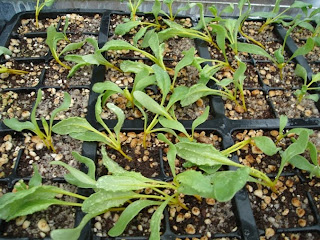
FEB 2010:
Around the middle of Feb 2010 our Cert 3 group went on a trip to Red Knights Fruit Farm. The Farm is a large Orchard which grows many types of fruit trees. Nathan Morrison was there to show us some budding techniques on Peach trees. There are two types of budding proceedures which work really well on Peach trees.
The two types are called T Budding and Chip Budding. The fastest and easiest one is chip budding. We did not do any T budding.
Chip Budding: This process involves 2 cuts both on the stock plant and the other on the scion. The first cut is made at a downward angle of 45 to 60 degrees and a depth of around 2mm. The second cut is made about 3/4 higher and then down to meet the first the cut. The chip created where the bud is on the scion wood is then removed and placed into the root stock cut. It is important that both chips are a similar size so they match up properly. The final step is to wrap the new bud to the the root stock with grafting tape.
There are many different fruit trees as well as roses that use chip and T Budding.
Please also not that the root stock that was used were suckers that had come up from Peach trees that had been chopped down to a stump. It was important to use the same type of rootstock and scion wood.
A week later we again did Chip budding with Nathan in our school nursery. This time we also did T Budding.
The rose rootstocks were cut into 100mm lengths and around a pencil thick. The bottom nodes were removed to prevent further suckering. Once this was done we then did the Chip Budding.
T-Budding: A T cut is made on the rootstock. A downward cut of around 3-4cm and a top slit (to form a T) of around 1-2cm. Going in around 2mm until the cambion layer is exposed. A bud is then removed from the scion wood. Cut out the bud 2cmm below and 1cm above, making a shallow cut. Then insert the bud into the T cut and wrap with grafting taped.
Once the new buds were on the root stock both ends of the rootstock were dipped in hormone gel. These were placed in forestry tubes that were filled with prop mix.
Scion wood- Rosa Iceberg
Rootstock- Rosa floribunda
Tools and equipment:
Secatuers
Grafting tape
Budding knife
Hormone Gel
Prop mix




























